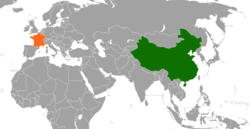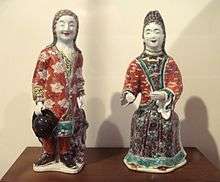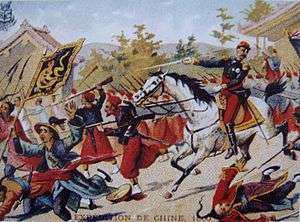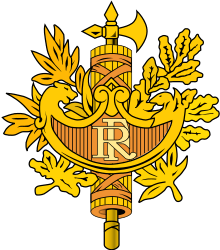China–France relations
China–France relations, also known as Sino-French relations or Franco-Chinese relations, refers to the interstate relations between China and France (Kingdom or later).
 | |
France |
China |
|---|---|
| China–France relations | |||||||
|---|---|---|---|---|---|---|---|
| Chinese name | |||||||
| Traditional Chinese | 中法關係 | ||||||
| Simplified Chinese | 中法关系 | ||||||
| |||||||
| French name | |||||||
| French | Relations franco-chinoises | ||||||
Note that the meaning of both "China" and "France" as entities has changed throughout history; this article will discuss what was commonly considered 'France' and 'China' at the time of the relationships in question. There have been many political, cultural and economic relationships between the two countries since medieval times. Rabban Bar Sauma from China visited France and met with King Philip IV of France. William of Rubruck encountered the French silversmith Guillaume Bouchier in the Mongol city Karakorum.
History
17th and 18th centuries

In 1698-1700 CE first French embassy to China took place via sea route.[1] Numerous French Jesuits were active in China during the 17th and 18th centuries: Nicolas Trigault (1577–1629), Alexander de Rhodes (1591–1660, active in Vietnam), Jean-Baptiste Régis (1663–1738), Jean Denis Attiret (1702–1768), Michel Benoist (1715–1774), Joseph-Marie Amiot (1718–1793).
French Jesuits pressured the French king to send them to China with the aims of counterbalancing the influence of Ottoman Empire in Europe. The Jesuits sent by Louis XIV were: Jean de Fontaney (1643–1710), Joachim Bouvet (1656-1730), Jean-François Gerbillon (1654–1707), Louis Le Comte (1655–1728) and Claude de Visdelou (1656–1737).[2] Returning to France, they noticed the similarity between Louis XIV of France and the Kangxi Emperor of China. Both were said to be servants of God, and to control their respective areas: France being the strongest country of Europe, and China being the strongest power in East Asia. Other biographical factors lead commentators to proclaim that Louis XIV and the Kangxi Emperor were protected by the same angel. (In childhood, they overcame the same illness; both reigned for a long time, with many conquests.)

Under Louis XIV's reign, the work of these French researchers sent by the King had a notable influence on Chinese sciences, but continued to be mere intellectual games, and not tools to improve the power of man over nature. Conversely, Chinese culture and style became fashionable in France, exemplified by the Chinoiserie fashion, and Louis XIV had the Trianon de Porcelaine built in Chinese style in 1670.[3] France became the European center for Chinese porcelains, silks and lacquers and European imitations of these goods.[4]

At the same time, the first ever known Chinese people came to France. Michel Sin arrived in Versaille in 1684 before continuing on to England. More notable was Arcadio Huang, who crossed France in 1702, spent some time in Rome (as a result of the Chinese Rites controversy), and returned to Paris in 1704, where he was the "Chinese interpreter of the King" before he died in 1716. He started the first ever Chinese-French dictionary, and a Chinese grammar to help French and European researchers to understand and study Chinese, but died before finishing his work.
Paris-based geographers processed reports and cartographic material supplied by mostly French Jesuit teams traveling across the Qing Empire, and published a number of high-quality works, the most important of which was Description de la Chine et de la Tartarie Chinoise edited by Jean-Baptiste Du Halde (1736), with maps by Jean Baptiste Bourguignon d'Anville.
In the 18th century, the French Jesuit Michel Benoist, together with Giuseppe Castiglione, helped the Qianlong Emperor build a European-style area in the Old Summer Palace (often associated with European-style palaces built of stone), to satisfy his taste for exotic buildings and objects. Jean Denis Attiret became a painter to the Qianlong Emperor. Joseph-Marie Amiot (1718–1793) also won the confidence of the emperor and spent the remainder of his life in Beijing. He was official translator of Western languages for the emperor, and the spiritual leader of the French mission in Peking.[5]
19th century
French Catholic missionaries were active in China; they were funded by appeals in French churches for money. The Holy Childhood Association (L'Oeuvre de la Sainte Enfance) was a Catholic charity founded in 1843 to rescue Chinese children from infanticide. It was a target of Chinese anti-Christian protests notably in the Tianjin Massacre of 1870. Rioting sparked by false rumors of the killing of babies led to the death of a French consul and provoked a diplomatic crisis.[6]
Relations between Qing China and France deteriorated in the European rush for markets and as European opinion of China deteriorated, the once admired empire would become the subject of unequal treaties and colonisation. In 1844, China and France concluded its first modern treaty, the Treaty of Whampoa, which demanded for France the same privileges extended to Britain. In 1860, the Summer Palace was ransacked by Anglo-French units and many precious objects found their way into French museums following this looting.
Later, France would seize Guangzhouwan as a treaty port, and take its own concession in the treaty port of Shanghai. Kwangchow Wan, (Guangzhouwan), was leased by China to France for 99 years (or until 1997, as the British did in Hong Kong's New Territories), according to the Treaty of 12 April 1898, on 27 May as Territoire de Kouang-Tchéou-Wan, to counter the growing commercial power of British Hong Kong[7] and was effectively placed under the authority of the French Resident Superior in Tonkin (itself under the Governor General of French Indochina, also in Hanoi); the French Resident was represented locally by Administrators.[8]

Second Opium war
Sino-French war, 1884-1885
For centuries China had claimed the Indo-China territory to its south as a tributary state, but France began a series of invasions, turning French Indochina into its own colony.[9] France and China clashed over control of Annam. The result was a conflict in 1884–85. The undeclared war was militarily a stalemate, but it recognize that France had control of Annam and Indochina was no longer a tributary of China. The main political result was that the war strengthened the control of Empress Dowager Cixi over the Chinese government, giving her the chance to block modernization programs needed by the Chinese military. The war was unpopular in France and it brought down the government of Prime Minister Jules Ferry. Historian Lloyd Eastman concluded in 1967:
- The Chinese, although fettered by outmoded techniques and shortages of supplies, had fought the French to a stalemate. China lost, it is true, its claim to sovereignty over Vietnam, and that country remained under French dominance until 1954. But the French had been denied an indemnity; railroad construction had been averted; and imperial control of the southern boundaries of the rich natural resources lying within those boundaries had not been broken. In short, China was not much changed by the war.[10]
Railway construction
20th century
In 1900, France was a major participant in the Eight-Nation Alliance which invaded China to put down the Boxer Rebellion. In the early 20th century Chinese students began to come to France. Li Shizeng, Zhang Renjie, Wu Zhihui, and Cai Yuanpei formed an anarchist group which became the basis for the Diligent Work-Frugal Study Movement. Zhang started a gallery which imported Chinese art, and the dealer C.T. Loo developed his Paris gallery into an international center.
In 1907 France and Japan signed an agreement to recognize the Open Door policy in China, regarding trade.[11]
The French Third Republic recognized the establishment of the Republic of China and established diplomatic relations on 7 October 1913. After the outbreak of war, the French government recruited Chinese workers to work in French factories. Li Shizeng and his friends organized the Société Franco-Chinoise d'Education (華法教育會 HuaFa jiaoyuhui) in 1916. Many worker-students who came to France after the war became high level members of the Chinese Communist Party. These included Zhou Enlai and Deng Xiaoping. The Institut Franco Chinoise de Lyon (1921—1951) promoted cultural exchanges.[12]
During World War II, Free France and China fought as allied powers against the Axis powers of Germany, Italy and Japan. After the invasion of France in 1940, although the newly formed Vichy France was an ally of Germany, it continued to recognize the Kuomintang government of Chiang Kai-shek—which had to flee to Chongqing in the Chinese interior after the fall of Nanjing in 1937—rather than the Japanese-sponsored Reorganized National Government of China under Wang Jingwei. French diplomats in China remained accredited to the government in Chongqing.[13]
On 18 August 1945 in Chongqing, while the Japanese were still occupying Kwangchow Wan following the surrender, a French diplomat and Kuo Chang Wu, Vice-Minister of Foreign Affairs of the Republic of China, signed the Convention between the Provisional Government of the French Republic and the National Government of China for the retrocession of the Leased Territory of Kouang-Tchéou-Wan. Almost immediately after the last Japanese occupation troops had left the territory in late September, representatives of the French and the Chinese governments went to Fort-Bayard to proceed to the transfer of authority; the French flag was lowered for the last time on 20 November 1945.[14]
During the Cold War era, 1947–1991, France first established diplomatic relations with the People's Republic of China in 1964. France played a minor role in the Korean War. In the 1950s, communist insurgents based in China repeatedly invaded and attacked French facilities in Indochina. After a major defeat by the Vietnamese communists at Dien Bien Phu in 1954, France pulled out and turned North Vietnam over to the Communists. By exiting Southeast Asia, France avoided confrontations with China. However, the Cultural Revolution sparked violence against French diplomats in China, and relationships cooled. The powerful French Communist Party generally supported the Soviet Union in the Sino-Soviet split and China had therefore a very weak base of support inside France, apart from some militant students.[15]
Cold War relations
After the Chinese Civil War (1927–1950) and the establishment of the new communist-led People's Republic of China (PRC) on 1 October 1949, the French Fourth Republic government did not recognize the PRC. Instead, France maintained relations with the Republic of China on Taiwan. However, by 1964 France and the PRC had re-established ambassadorial level diplomatic relations. This was precipitated by Charles de Gaulle's official recognition of the PRC. Before the Chinese Civil War, Deng Xiaoping had completed his studies in Paris prior to ascending to power in China.
Post-Cold War
This state of relations would not last, however. During the 1990s, France and the PRC repeatedly clashed as a result of the PRC's One China Policy. France sold weapons to Taiwan, angering the Beijing government. This resulted in the temporary closure of the French Consulate-General in Guangzhou. France eventually agreed to prohibit local companies from selling arms to Taiwan, and diplomatic relations resumed in 1994. Since then, the two countries have exchanged a number of state visits. Today, Sino-French relations are primarily economic. Bilateral trade reached new high levels in 2000. Cultural ties between the two countries are less well represented, though France is making an effort to improve this disparity. France has expanded its research facilities dealing with Chinese history, culture, and current affairs.[16]
2008 rifts
In 2008, Sino-French relations took a downturn in the wake of the 2008 Summer Olympics torch relay. As torchbearers passed through Paris, activists fighting for Tibetan independence and human rights repeatedly attempted to disrupt, hinder or halt the procession.[17] The Chinese government hinted that Sino-French friendship could be affected[18] while Chinese protesters organized boycotts of the French-owned retail chain Carrefour in major Chinese cities including Kunming, Hefei and Wuhan.[19] Hundreds of people also joined anti-French rallies in those cities and Beijing.[20] Both governments attempted to calm relations after the demonstrations. French President Nicolas Sarkozy wrote a letter of support and sympathy to Jin Jing, a Chinese athlete who had carried the Olympic torch.[21] Chinese President Hu Jintao subsequently sent a special envoy to France to help strengthen relations.[22]
However, relations again soured after President Sarkozy met the Dalai Lama in Poland in 2009. Chinese Prime Minister Wen Jiabao omitted France in his tour of Europe in response, his assistant foreign minister saying of the rift "The one who tied the knot should be the one who unties it."[23] French Prime Minister Jean-Pierre Raffarin was quoted in Le Monde as saying that France had no intention of "encourag[ing] Tibetan separatism".[24]
Human rights
Persecution of Uyghurs in Xinjiang
In October 2019, British UN Ambassador Karen Pierce delivered a joint statement on Xinjiang at the General Assembly’s Third Committee on Tuesday on behalf of 23 countries, including Finland. The countries said they shared concerns raised by the United Nations International Convention on the Elimination of All Forms of Racial Discrimination regarding “credible reports of mass detention; efforts to restrict cultural and religious practices; mass surveillance disproportionately targeting ethnic Uyghurs; and other human rights violations and abuses.” They called on China to comply with its national and international obligations to respect human rights, including freedom of religion, and allow UN human rights monitors access to detention centers. ][25]
Hong Kong
In June 2020, France openly opposed the Hong Kong national security law[26]
Trade deals 2019
At a time when United States-China trade relations are deeply troubled, with a tariff war underway, President Emmanuel Macron and President Xi Jinping in late March, 2019, signed a series of large-scale trade agreements that covers many sectors over a period of years. The centerpiece was a €30 billion purchase of airplanes from Airbus. It came at a time when the leading American firm, Boeing, saw its entire fleet of new 737 MAX passenger planes grounded worldwide. Going well beyond aviation, the new trade agreement covered French exports of chicken, a French-built offshore wind farm in China, and a Franco-Chinese cooperation fund, as well as billions of Euros of co-financing between BNP Paribas and the Bank of China. Other plans include billions of euros to be spent on modernizing Chinese factories, as well as new ship building.[27]
Public opinion
Survey published in 2019 by the Pew Research Center found that 62% of French had an unfavourable view of China.[28]
Resident diplomatic missions
- China has an embassy in Paris and consulates-general in Lyon, Marseille, Saint-Denis and Strasbourg and a consulate in Papeete.[29]
- France has an embassy in Beijing and consulates-general in Chengdu, Guangzhou, Hong Kong, Shanghai, Shenyang and Wuhan.[30]
 Embassy of China in Paris
Embassy of China in Paris- Consulate-General of China in Saint-Denis, Réunion
See also
- History of Chinese foreign policy
- Foreign relations of China
- China Policy Institute
- Anglo-Chinese relations
References
- Translated by S. Bannister, 1859, A journal of the first French embassy to China, 1698-1700
- Eastern Magnificence and European Ingenuity: Clocks of Late Imperial China - p. 182 by Catherine Pagani (2001)
- Shapely Bodies: The Image of Porcelain in Eighteenth-Century France - p. 44-52 by Christine A. Jones (2013)
- Lach, Donald F. (June 1942). "China and the Era of the Enlightenment". The Journal of Modern History. University of Chicago Press. 14 (2): 211. doi:10.1086/236611. JSTOR 1871252.
- Alain Peyrefitte, Images de l'Empire Immobile, p. 113
- Henrietta Harrison, "'A Penny for the Little Chinese': The French Holy Childhood Association in China, 1843–1951." American Historical Review 113.1 (2008): 72-92. online
- A. Choveaux, 1925, pp. 74–77
- Olson 1991: 349
- Immanuel C. Hsu, Rise of modern China (1975) pp 389-94.
- Lloyd E. Eastman, Throne and Mandarins: China's Search for a Policy during the Sino-French controversy, 1880-1885 (Harvard University Press, 1967) pp 102-3, 189, quoting page 202.
- "Arrangement between France and Japan Concerning their Policies in China" American Journal of International Law, (1910) Volume 4. online
- Ge Fuping, "Some Problems Concerning Institut Franco-Chinoise de Lyon [J]." Modern Chinese History Studies 5 (2000).
- Young, Ernest (2013), Ecclesiastical Colony: China's Catholic Church and the French Religious Protectorate, Oxford University Press, pp. 250–251, ISBN 978-0199924622
- Matot, p. 214-217.
- Bhagwan Sahai Bunkar, "Sino-French Diplomatic Relations: 1964-81." China Report 20#1 (Feb 1984) pp 41-
- Marianne Bastid‐Bruguière, "Current trends in Chinese studies in France." Journal of Modern Chinese History 2.1 (2008): 115-132.
- "China condemns Olympic torch disruptions" Archived April 12, 2008, at the Wayback Machine, France 24, April 8, 2008
- "Raidissement des relations sino-françaises", Radio France Internationale, April 15, 2008
- "National flag of France with Hakenkreuz added by Chinese protesters" (in French). Reuters. 2008-04-19. Retrieved 2008-04-19.
- "Anti-French rallies across China", BBC, April 19, 2008
- "«Chère mademoiselle Jin Jing, je voudrais vous dire toute mon émotion...»", Libération, April 28, 2008
- "La porte-parole du ministère des AE appelle aux efforts conjoints de la Chine et de la France pour promouvoir les relations bilatérales", The People's Daily, April 23, 2008
- "China ready to mend ties if France moves first" Archived 2012-03-21 at the Wayback Machine, AFP, January 22, 2009
- "'Encore du travail' pour des retrouvailles entre Pékin et Paris (Raffarin)", Le Monde, February 10, 2009
- Charbonneau, Louis (30 October 2019). %5b%5bHuman Rights Watch%5d%5d "Countries Blast China at UN Over Xinjiang Abuses" Check
|url=value (help). Retrieved 3 July 2020. - Lawler, Dave (2 July 2020). "The 53 countries supporting China's crackdown on Hong Kong". Axios. Retrieved 3 July 2020.
- Rym Momtaz, "Macron steals Trump’s thunder with Chinese Airbus order: France lands €30B aviation deal with Beijing," POLITICO March 25, 2019
- "People around the globe are divided in their opinions of China". Pew Research Center. 30 September 2019.
- Embassy of China in Paris
- Embassy of France in Beijing
References
- The China Quarterly, 169, Cambridge University Press, 2002, pp. 33–44, doi:10.1017/S0009443902000049
Further reading
- Becker, Bert. "France and the Gulf of Tonkin region: Shipping markets and political interventions in south China in the 1890s." Cross-Currents: East Asian History and Culture Review 4.2 (2015): 560–600. online
- Bonin, Hubert. French banks in Hong Kong (1860s-1950s): Challengers to British banks?" Groupement de Recherches Economiques et Sociales No. 2007-15. 2007.
- Bunkar, Bhagwan Sahai. "Sino-French Diplomatic Relations: 1964-81" China Report (Feb 1984) 20#1 pp 41–52
- Césari, Laurent, & Denis Varaschin. Les Relations Franco-Chinoises au Vingtieme Siecle et Leurs Antecedents ["Sino-French relations in the 20th century and their antecedents"] (2003) 290 pp.
- Chesneaux, Jean, Marianne Bastid, and Marie-Claire Bergere. China from the Opium Wars to the 1911 Revolution (1976) Online.
- Clyde, Paul Hibbert. The Far East (3rd ed 1947) online
- Cabestan, Jean-Pierre. "Relations between France and China: towards a Paris-Beijing axis?." China: an international journal 4.2 (2006): 327–340. online
- Christiansen, Thomas, Emil Kirchner, and Uwe Wissenbach. The European Union and China (Macmillan International Higher Education, 2019).
- Clyde, Paul Hibbert, and Burton F. Beers. The Far East: A History of Western Impacts and Eastern Responses, 1830-1975 (1975).
- Cotterell, Arthur. Western Power in Asia: Its Slow Rise and Swift Fall, 1415 - 1999 (2009) popular history; excerpt
- Eastman, Lloyd E. Throne and Mandarins: China's Search for a Policy during the Sino-French controversy, 1880-1885 (Harvard University Press, 1967)
- Gundry, Richard S. ed. China and Her Neighbours: France in Indo-China, Russia and China, India and Thibet (1893), magazine articles online.
- Hughes, Alex. France/China: intercultural imaginings (2007) online
- Mancall, Mark. China at the center: 300 years of foreign policy (1984). passim.
- Pieragastini, Steven. "State and Smuggling in Modern China: The Case of Guangzhouwan/Zhanjiang." Cross-Currents: East Asian History and Culture Review 7.1 (2018): 118–152. online
- Skocpol, Theda. "France, Russia, China: A structural analysis of social revolutions." Comparative Studies in Society and History 18.2 (1976): 175–210.
- Upton, Emory. The Armies of Asia and Europe: Embracing Official Reports on the Armies of Japan, China, India, Persia, Italy, Russia, Austria, Germany, France, and England (1878). Online
- Wellons, Patricia. "Sino‐French relations: Historical alliance vs. economic reality." Pacific Review 7.3 (1994): 341–348.
- Weske, Simone. "The role of France and Germany in EU-China relations." CAP Working Paper (2007) online.
- Young, Ernest. Ecclesiastical Colony: China's Catholic Church and the French Religious Protectorate, (Oxford UP, 2013)
.svg.png)
